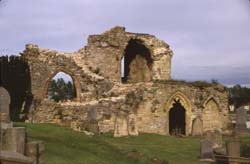 |
 |
 |
 |
 |
 |
 |
|
|
Cistercian Abbeys: KINLOSS Name: KINLOSS Location: Kinloss
village County: Moray Kinloss was founded in 1150 by King David I of Scotland and was colonized with monks from Melrose. According to tradition, it was God who guided the king to establish a monastery at Kinloss. Allegedly, David lost his way in a thick wood during a hunting expedition and, in answer to his prayers, he received the guidance of a white dove. He followed the dove into a clearing where he found two shepherds tending their flocks. They provided the king with food and shelter. During the night, David had a dream in which he was warned that he should erect a chapel in honour of the Virgin Mary to show his thanks for the aid he had received at her hands. On waking he vowed to act upon his dream. Accordingly, the king called together a team of architects and masons and he himself resided at Duffus Castle so that he could preside over the construction of the abbey. David was called away on other affairs before the monastery could be completed, but he sent for a monk from Melrose to supervise the remaining work. This monk was later made first abbot of Kinloss. In the early thirteenth century there were as many as twenty-five monks living at the monastery. The community was soon in a position to expand the Cistercian Order and Kinloss sent out two colonies in the space of two years: Culross (1217) and New Deer (1219). The house soon acquired a special prominence and importance as the only abbey to be founded in the extensive province in Moray. In 1303 King Edward I, while on his progress through the north of Scotland, stayed at Kinloss for three weeks with a large retinue and received the fealty of Abbot Thomas. The monastery received many generous endowments from King David and his successors. For example, in 1312 Robert I (The Bruce) granted Kinloss rights to the valuable salmon fishings on the River Findhorn, and in 1362 Earl of Sutherland bestowed upon the abbey the hospital and lands of John the Baptist of Hebnisden. In 1395 the abbacy was granted the Mitre with a seat in Parliament. However, during the fourteenth and fifteenth centuries stories of scandals started to spread and accounts of the immorality of the abbot and his monks were beginning to give cause for concern in Rome and at Citeaux. As a result, an envoy was sent from Citeaux to correct their evil ways. In 1492 further scandal hit the abbey when a monk, William Butler, mudered a young boy whom he struck in the cloister, in a fit of anger. Butler was sent to Rome under the escort of another monk, to receive his punishment from the pope. Letters of absolution were received by the abbey but neither monk was seen again. Abbot Chrystal (1504-1528) did much to reinvigorate the spiritual life of the abbey and, at the same time, spught to maintain the material welfare of the household, for example, church furnishings and library books. In 1528 Chrystal resigned in favour of Robert Reid, who was the second-last pre-Reformation abbot and probably the greatest that the monastery had seen. During his abbacy, Robert also held the priory of Beauly in commendam. Robert was a learned and wise man and in the 1530s he brought the Italian scholar, Giovanni Ferrerio, to Kinloss, where his teaching over five years made Kinloss a centre of academic excellence. Robert also commissioned the artist, Andrew Bairhum, to paint a number of altarpieces for the abbey church and to decorate some of his own rooms. In addition, Robert erected a new library and other buildings at the abbey whilst carefully administering the estate. During his term in office, Robert Reid was sent as the king’s commissioner to discuss peace with Henry VIII and again to France in connection with the marriage of James V. In 1541 Robert was made bishop of Orkney and continued in his post at Kinloss until 1553 when he resigned in favour of his nephew, Walter Reid. Following his death Robert Reid became founder and benefactor of Edinburgh University, a legacy which lasts till this day. Walter Reid inherited the abbacy of one of the
richest Cistercian houses in Scotland; in 1561 the annual income
of the abbey was valued at £3480, ranking Kinloss third wealthiest
after Coupar Angus and Melrose.
However, following the Reformation Walter granted a deed of demission
in favour of Edward Bruce, and
he systematically dismantled the wealth and fabric of the church.
In 1601 the abbey was erected into a temporal lordship for Edward
Bruce, who took the title lord of Kinloss. The ruins were eventually
sold to Alexander Brodie of Lethen in 1643 who sold the stone on
to Cromwell in 1650 for the construction of the Citadel at Inverness.
|
